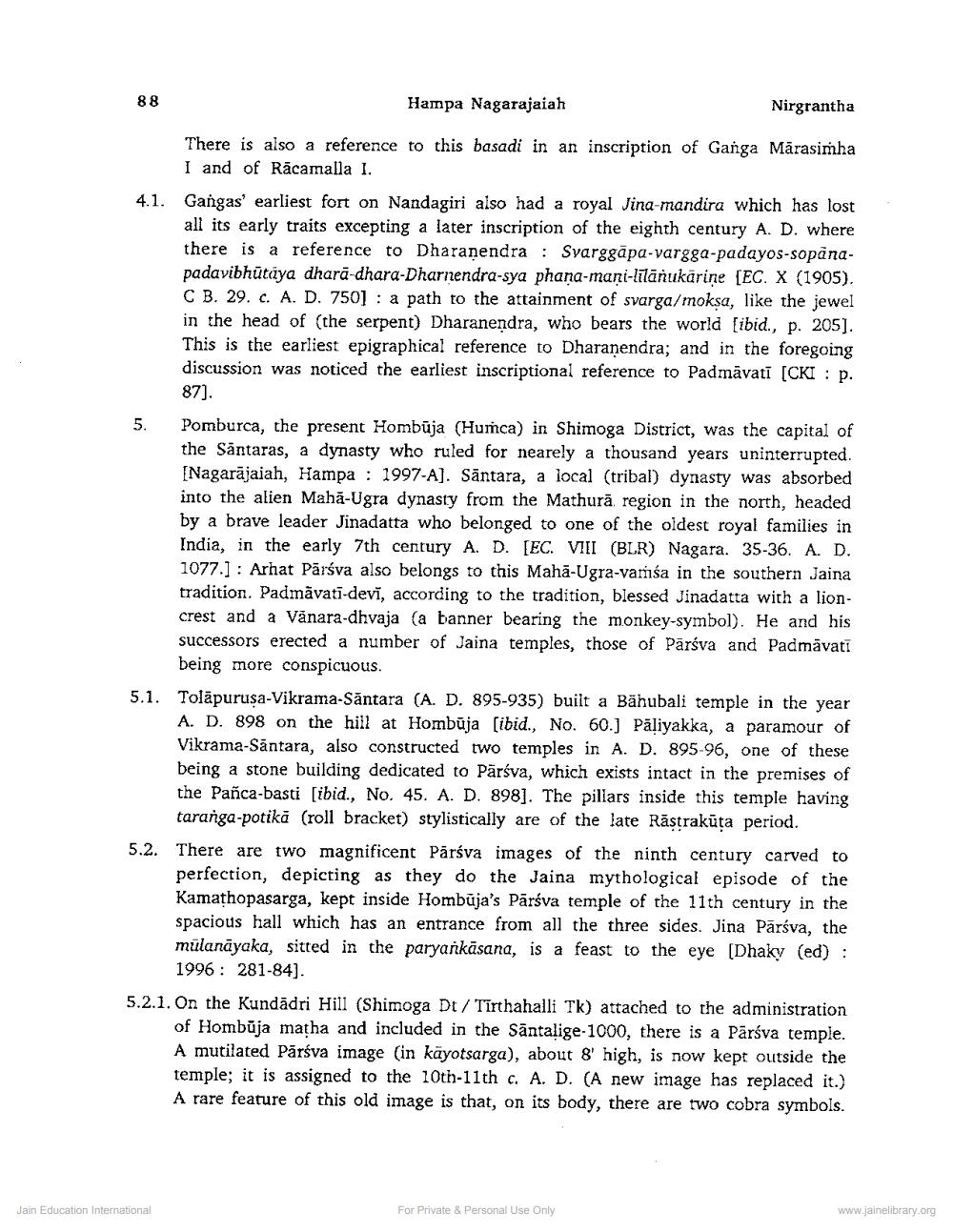Book Title: Jin Parsva and His Temples in Inscriptions of Karnataka Author(s): Hampa Nagrajaiha Publisher: Z_Nirgrantha_1_022701.pdf and Nirgrantha_2_022702.pdf and Nirgrantha_3_022703.pdf View full book textPage 5
________________ 88 Hampa Nagarajaiah Nirgrantha There is also a reference to this basadi in an inscription of Ganga Mārasimha I and of Rācamalla I. 4.1. Gangas' earliest fort on Nandagiri also had a royal Jina-mandira which has lost all its early traits excepting a later inscription of the eighth century A. D. where there is a reference to Dharanendra : Svarggāpa-vargga-padayos-sopanapadavibhūtaya dhara-dhara-Dharnendra-sya phana-mani-lītānukarine [EC. X (1905). C B. 29. c. A. D. 750) : a path to the attainment of svarga/moksa, like the jewel in the head of the serpent) Dharanendra, who bears the world (ibid., p. 205). This is the earliest epigraphical reference to Dharanendra; and in the foregoing discussion was noticed the earliest inscriptional reference to Padmavati (CKI : p. 87). Pomburca, the present Hombūja (Humca) in Shimoga District, was the capital of the Säntaras, a dynasty who ruled for nearely a thousand years uninterrupted. [Nagarājaiah, Hampa : 1997-A]. Sāntara, a local (tribal) dynasty was absorbed into the alien Maha-Ugra dynasty from the Mathurā region in the north, headed by a brave leader Jinadatta who belonged to one of the oldest royal families in India, in the early 7th century A. D. [EC. VIII (BLR) Nagara. 35-36. A. D. 1077.] : Arhat Pārsva also belongs to this Mahā-Ugra-vamśa in the southern Jaina tradition. Padmavati-devī, according to the tradition, blessed Jinadatta with a lioncrest and a vānara-dhvaja (a banner bearing the monkey-symbol). He and his successors erected a number of Jaina temples, those of Parśva and Padmavati being more conspicuous. 5.1. Tolāpuruşa-Vikrama-Sántara (A. D. 895-935) built a Bahubali temple in the year A. D. 898 on the hill at Hombūja (ibid., No. 60.) Paliyakka, a paramour of Vikrama-Santara, also constructed two temples in A. D. 895-96, one of these being a stone building dedicated to Pārsva, which exists intact in the premises of the Panca-basti (ibid., No. 45. A. D. 898]. The pillars inside this temple having taranga-potikā (roll bracket) stylistically are of the late Rāstrakūta period. 5.2. There are two magnificent Pārsva images of the ninth century carved to perfection, depicting as they do the Jaina mythological episode of the Kamathopasarga, kept inside Hombūja's Pārśva temple of the 11th century in the spacious hall which has an entrance from all the three sides. Jina Pārśva, the mülanāyaka, sitted in the paryankāsana, is a feast to the eye (Dhaky (ed): 1996 : 281-84). 5.2.1. On the Kundādri Hill (Shimoga Dt / Tīrthahalli Tk) attached to the administration of Hombūja matha and included in the Sāntalige-1000, there is a Pārsva temple. A mutilated Pārśva image (in käyotsarga), about 8' high, is now kept outside the temple; it is assigned to the 20th-11th c. A. D. (A new image has replaced it.) A rare feature of this old image is that, on its body, there are two cobra symbols. Jain Education International For Private & Personal Use Only For Private & Personal Use Only www.jainelibrary.orgPage Navigation
1 ... 3 4 5 6 7 8 9 10 11 12 13 14 15 16 17 18 19 20 21 22 23
